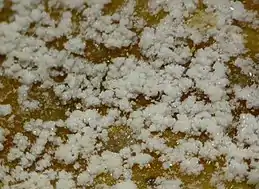| Jurbanite | |
|---|---|
 Jurbanite (field of view: 5 mm) | |
| General | |
| Category | Sulfate minerals |
| Formula (repeating unit) | AlSO4(OH)·5H2O |
| IMA symbol | Jur[1] |
| Strunz classification | 7.DB.15 |
| Dana classification | 31.9.10.1 |
| Crystal system | Monoclinic |
| Crystal class | Prismatic (2/m) (same H-M symbol) |
| Space group | P21/n |
| Identification | |
| Color | Colorless |
| Crystal habit | Small crystals and stalactitic forms |
| Tenacity | Brittle |
| Mohs scale hardness | 2.5 |
| Luster | Vitreous |
| Diaphaneity | Transparent |
| Specific gravity | 1.786 |
| Optical properties | Biaxial (-) |
| Refractive index | nα = 1.459 nβ = 1.473 nγ = 1.483 |
| Birefringence | δ = 0.024 |
| 2V angle | Measured: 80° |
| Solubility | Soluble in water |
| References | [2][3][4] |
Jurbanite is a sulfate mineral with the chemical formula AlSO4(OH)·5H2O. Its molecular weight is 230.13 g/mol. It crystallizes in the monoclinic system and is dimorphous with the orthorhombic mineral rostite.[2] Jurbanite occurs as a secondary (post-mine) mineral in mines containing sulfide minerals.[3]
Jurbanite was first described for an occurrence in the San Manuel mine of Pinal County, Arizona and first described in 1976s. It was named for Joseph John Urban, the mineral collector who discovered it.[2]
References
- ↑ Warr, L.N. (2021). "IMA–CNMNC approved mineral symbols". Mineralogical Magazine. 85 (3): 291–320. Bibcode:2021MinM...85..291W. doi:10.1180/mgm.2021.43. S2CID 235729616.
- 1 2 3 Mindat.org - Jurbanite
- 1 2 Webmineral - Jurbanite
- ↑ "Handbook of Mineralogy - Jurbanite" (PDF). Archived from the original (PDF) on 2016-03-03. Retrieved 2013-01-25.
This article is issued from Wikipedia. The text is licensed under Creative Commons - Attribution - Sharealike. Additional terms may apply for the media files.